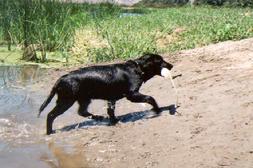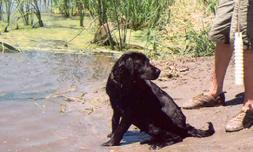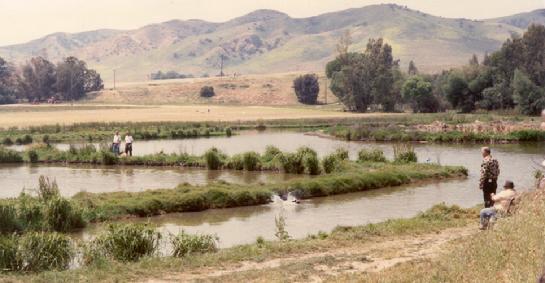Training In Water
Once your dog has become a confident swimmer, you can begin some serious water training. To start off, always set up water retrieves with straight entries! This means the line and the fall are in a straight line, perpendicular to the shore: no angles. With a young dog, starting angled entries too soon can encourage "bank running", bad habits and lost birds. Start out with nice open water straight retrieves where the dog has no other choice than to go straight in and come back straight out. Your dog should be 99% reliable (nothing is 100%) at basic straight water entry retrieves before you start angled entries. Some dogs will run a bank given any opportunity, so don't give them the opportunity.
|
If your dog drops the bird as soon as he hits the land, try running backwards away from the line while calling your dog as soon as he is within a few feet of the shoreline. If this doesn't work, teach your dog the word "hold" at home. Most pups will drop the bird when they hit land, and most seem to grow out of the habit by themselves.
|
To start angled entries, find a pond with a straight shoreline. Throw the first bird straight out into the water (20 yards is fine, we are teaching a concept, not testing endurance). Move six feet down the bank and throw the mark in the exact same place as the first fall. Your dog should wnter the water from the lin, not run down the bank to "square off" the retrieve. Repeat retrieve #2, and then move another 6' down the bank. Throw the mark in the exact same place as the first three marks. If your dog starts to run the bank, try moving the line up to the water's edge, or have his (and your) feet in the water when you send him. If he is squaring off on his returns, keep him in the water by continuing to walk down the bank and calling him until his exit is in the same spot as his entry. One word of caution: do not progress too quickly or your dog will start running the bank. Go slowly, and don't hesitate to back up and start over with the concept.
|
Next thing is to train on is BIG water. By big water, we mean a very large open pond or lake with no tules or spits of land. Most young dogs are a bit hesitant at first in wide-open water, so don't be surprised if your dog initially seems lost or confused. Pay attention to where the sun's reflection is hitting the water when setting up a big water retrieve. Be certain that the dog will be able to see the bird easily once he gets to the area of the fall. You will need to find a large clear pond or lake and have a thrower to help you. Check out the sun's reflection and then send your thrower to the far side of the pond. The fall should be far enough into the pond so that the dog will not be tempted to run the bank. Do not let your dog watch the thrower walk around the pond - he may decide to run around the pond and enter the water from where your thrower is standing. This is not what we are going for here! If your dog starts to look concerned or confused during his swim out to the fall, have the thrower help him by "hey, hey"-ing or throwing rocks at the fall. Your big water retrieves should range from 70m- 100 yards in length. This may seem very simple and straightforward to you, but most dogs are not initially comfortable in big water situations, so it is worth your while to train on them. Just be sure that your thrower knows when and how to help your dog before you start out.
|
One more water feature that you should introduce your dog to are various types of water entries. Initailly, when you are teaching your pup to swim and letting him build up his confidence, you will use easy, walk-in entries.
|
 |
| 4 months |
|
|
 |
| 4 months old |
|
|
Later, you will want to look for steep banks, immediate deep water, and boat entries. As situations become available during your training days, let your dog ry new types of entries, and practice them until he is comfortable.
| |
Before your dog gets too set on the idea that "water entry means bird is always in the water", start some simple water/land marks. Either look for a narrow channel of water (one that you can throw across) or have a helper throw for you. Have a nice high throw to give the dog a good chance to mark the fall. If you can find a channel of water with a hill on one side, throw the bird on the hillside so that the dog can clearly see the fall. Be prepared for your dog to stop when he reaches the far water's edge and hunt in the water for his mark. Have your helper "hey, hey" or throw rocks to get the dog to his mark. Do whatever is necessary to get him out of the water quickly before he forgets where the fall is. Repeat this exercise frequently, and mix it up with marks that are in the water once your dog has the water/land concept down.
|
 |
| Going out |
|
|
 |
| Coming back |
|
|
The next step is water/land/water marks. How you set these marks up will depend on the type of water that is available. Look for a channel of water next to a pond, or two channels of water with land separating them, or two ponds with a road in between. The idea is to have the dog enter the water, get out onto land, and then re-enter new water to get to the mark. Try to keep angles and heavy cover out of the scenario until your dog has this concept down pat.
|
 |
| water/land/water |
|
|
Once your dog has thoroughly learned angled entries, water/land and water/land/water concepts, add cover, equipment (decoys, boats, blinds, shots from the line, duck calls), and hillsides to your marks. Don't go overboard and do everything in one retrieve, or even one day, but use these things to vary your training sessions and allow your dog to put all the little pieces together.
Have fun, and don't be afraid to get wet!
|
|
|